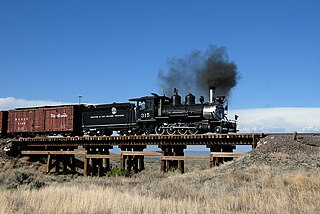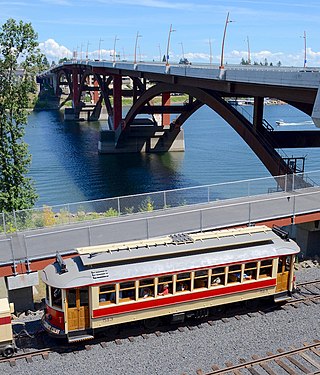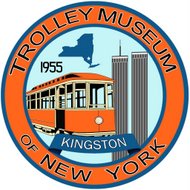
A heritage railway or heritage railroad is a railway operated as living history to re-create or preserve railway scenes of the past. Heritage railways are often old railway lines preserved in a state depicting a period in the history of rail transport.

Streetcars in New Orleans have been an integral part of the city's public transportation network since the first half of the 19th century. The longest of New Orleans' streetcar lines, the St. Charles Avenue line, is the oldest continuously operating street railway system in the world. Today, the streetcars are operated by the New Orleans Regional Transit Authority (RTA).

Conservation and restoration of rail vehicles aims to preserve historic rail vehicles.

The Willamette Shore Trolley is a heritage railroad or heritage streetcar that operates along the west bank of the Willamette River between Portland and Lake Oswego in the U.S. state of Oregon. The right-of-way is owned by a group of local-area governments who purchased it in 1988 in order to preserve it for potential future rail transit. Streetcar excursion service began operating on a trial basis in 1987, lasting about three months, and regular operation on a long-term basis began in 1990. The Oregon Electric Railway Historical Society has been the line's operator since 1995.

A Birney or Birney Safety Car is a type of streetcar that was manufactured in the United States in the 1910s and 1920s. The design was small and light and was intended to be an economical means of providing frequent service at a lower infrastructure and labor cost than conventional streetcars. Production of Birney cars lasted from 1915 until 1930, and more than 6,000 of the original, single-truck version were built. Several different manufacturers built Birney cars. The design was "the first mass-produced standard streetcar " in North America.

The TECO Line Streetcar is a heritage streetcar transit line in Tampa, Florida, run by the Hillsborough Area Regional Transportation Authority (HART), owned by the city of Tampa, and managed by Tampa Historic Streetcar, Inc. It connects Downtown and Channelside to the historic Ybor City district. There is also an "In-Town" trolley-replica bus system that connects Downtown, Channelside, and Harbour Island.

The F Market & Wharves line is one of several light rail lines in San Francisco, California. Unlike most other lines in the system, the F line runs as a heritage streetcar service, almost exclusively using historic equipment both from San Francisco's retired fleet as well as from cities around the world. While the F line is operated by the San Francisco Municipal Railway (Muni), its operation is supported by Market Street Railway, a nonprofit organization of streetcar enthusiasts which raises funds and helps to restore vintage streetcars.

Old Pueblo Trolley is a non-profit, educational corporation based in Tucson, in the U.S. state of Arizona, that is dedicated to the preservation of Arizona's mass transit history. The name also commonly refers to the heritage streetcar line which OPT began operating in 1993, on which service is currently indefinitely suspended. OPT consists of three divisions that each fill a specific role in preserving the state's mass transit history. The divisions are the Street Railway Division, Motor Bus Division and the Museum Division.

The Metro Streetcar, formerly known as the River Rail Streetcar, is a two line heritage streetcar system operating in Little Rock and North Little Rock, Arkansas. It has operated since November 1, 2004. Most recently expanded in 2007, the streetcar now operates over 3.4-mile (5.5 km) of track in a figure-eight loop pattern. The Metro Streetcar is operated by Rock Region Metro. In 2022, the system had a ridership of.

The Charlotte Trolley was a heritage streetcar that operated in Charlotte in the U.S. state of North Carolina. The line ran along the former Norfolk Southern right of way between Tremont Avenue in the Historic South End in a northerly direction to its terminus at 9th Street Uptown. It ran on tracks mostly shared with the LYNX Blue Line.

The Fort Collins Municipal Railway operated streetcars in Fort Collins, Colorado, from 1919 until 1951. Since 1984, a section of one of the former routes has been in operation as a seasonal heritage streetcar service, under the same name, running primarily on Spring and Summer weekends. The heritage service is operated by volunteers from the Fort Collins Municipal Railway Society (FCMRS). The streetcar in use on the heritage line, Birney "Safety" Streetcar No. 21, is listed on the National Register of Historic Places.

The McKinney Avenue Transit Authority (MATA), a non-profit organization, operates the M-Line Trolley in Dallas, Texas. In operation since 1989, it is an example of a heritage streetcar running historic cars. The M-Line Trolley operates 7 days per week, 365 days per year. Since 2002, the M-Line Trolley is free to the public, thanks to donations and a joint operating subsidy received from Dallas Area Rapid Transit (DART) and the Uptown Improvement District. The main stretch of the line runs along McKinney Avenue in Uptown between West Village and Klyde Warren Park / Dallas Arts District. The M-Line Trolley connects to the DART light rail system at CityPlace/Uptown on the northern end and St. Paul on the southern end.

The Trolley Museum of New York, a non-profit organization, is located at 89 East Strand Street, Kingston, New York. The museum is open to the public on a seasonal schedule, but volunteer activities relating to the preservation of historic transit are year-round.

Streetcars or trolley(car)s were once the chief mode of public transit in hundreds of North American cities and towns. Most of the original urban streetcar systems were either dismantled in the mid-20th century or converted to other modes of operation, such as light rail. Today, only Toronto still operates a streetcar network essentially unchanged in layout and mode of operation.

The MATA Trolley is a heritage streetcar transit system operating in Memphis, Tennessee. It began operating on April 29, 1993. Service was suspended in June 2014, following fires on two cars. After nearly four years and repeated postponements, the reopening of the Main Street Line took place on April 30, 2018. The system's two other lines remained suspended as of December 2022, but with reopening of both planned. In 2022, the system had a ridership of 346,700.

Established in 1982, the California Trolley and Railroad Corporation (CTRC) is a 501(c)(3) non-profit organization to preserve rail transportation in the Santa Clara Valley.
The Gomaco Trolley Company is a manufacturer of vintage-style streetcars, located in Ida Grove, Iowa, United States. The company has supplied replica-vintage streetcars to several transit systems in the US, and has also restored and rebuilt authentic vintage streetcars for some systems.

Birney Safety Streetcar No. 224 is a streetcar in Fort Smith, Arkansas, listed on the U.S. National Register of Historic Places. Built in 1926 by the American Car Company division of the J. G. Brill Company, it is a type of streetcar known as a Birney "Safety Car". It was listed on the National Register in 1994 and is one of fewer than 10 streetcars listed.

Fort Collins Municipal Railway Birney Safety Streetcar No. 21 is a streetcar in Fort Collins, Colorado, listed on the U.S. National Register of Historic Places. Built in 1919 by the American Car Company for the Fort Collins Municipal Railway, it is a type of streetcar known as a Birney "Safety Car". It was listed on the National Register in 1984 and is one of fewer than 10 streetcars listed.
























